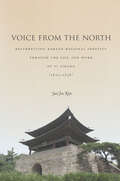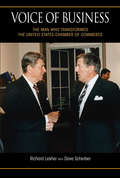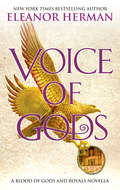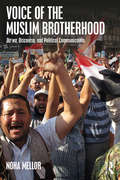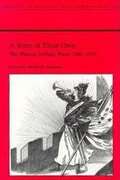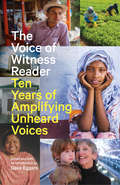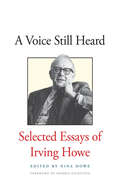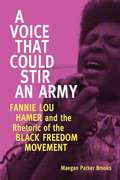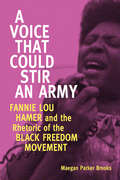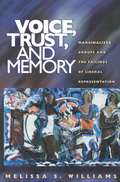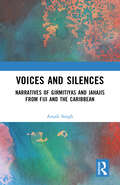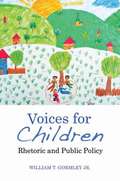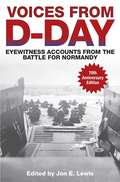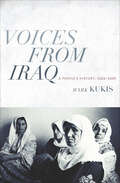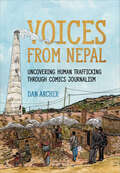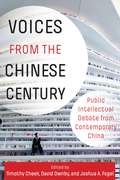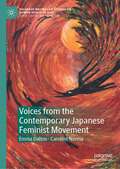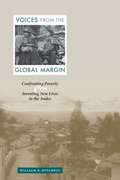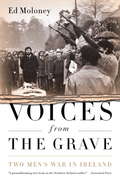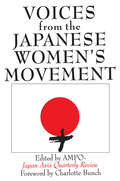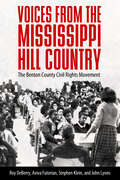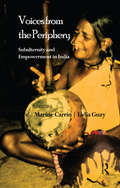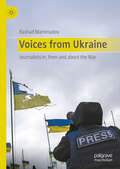- Table View
- List View
Voice from the North: Resurrecting Regional Identity Through the Life and Work of Yi Sihang (1672-1736)
by Sun Joo KimVoice from the Northresurrects the forgotten historical memory of the people and region in late Choson Korea while also enriching the social history of the country. Sun Joo Kim accomplishes this by examining the life and work of Yi Sihang, a historically obscure person from a hinterland in Korea's northwestern region who was also a member of the literati. Unlike many of his contemporaries, Yi Sihang left numerous writings on his region's history and culture, and on the political and social discrimination that he and others in his region faced from the central elite. This work explores a regional history and culture through the frames of microhistory and historical memory. Kim criticizes the historiographical problem of "otherizing" the northern region and fills a gap in Korean historiography—the lack of historical study of the northern region from a regional perspective, P'yongan Province in particular. The biographical format of this work engages readers in the investigation of a person's life within the changing world of his time and also creates a space where private and public intersect. Kim places Yi Sihang at the center of the historical stage while describing, analyzing, and reconstructing the world around him through his life story.
Voice of Business: The Man Who Transformed the United States Chamber of Commerce
by Dave Scheiber Richard LesherFrom small-town life to the world stage, Richard Lesher’s inspiring tale is one of dogged determination. The son of an alcoholic and violent father in Depression-era Pennsylvania, Lesher worked his way through school, eventually overseeing NASA’s vital technological transfer program during the race to the moon. His greatest achievement, however, was serving as president of the US Chamber of Commerce from the Ford through the Clinton administrations. Working closely with the presidents—especially Reagan—he modernized the Chamber over 22 years and dramatically expanded its national and international outreach. Believing strongly in the power of the free enterprise system, Lesher became a key voice and agent of economic change in former communist countries in the 1990s. Respected and admired by presidents, officials, and world leaders on both the left and right, Lesher has lived a hopeful and uniquely American story, a remarkable testament to personal perseverance and the ever-present opportunities in a free society.
Voice of Gods
by Eleanor HermanAt nineteen, Ada of Caria yearns to take the Snake Blood throne from her mad older siblings. She seeks the help of a young orphaned girl named Helen, the first True Oracle to have walked the earth in more than three hundred years.Helen may be able to channel the voice of the gods, but she hates her gift and will do anything to get rid of it--even lie to her best friend, Myrtale, the priestess-princess of Epirus who is destined to marry King Philip II of Macedon even though she loves another.And in the shadows lurks a handsome green-eyed stranger who has more at stake--and more to lose--than anyone could possibly imagine.Amid jealousy and heartbreak, torrid affairs and secret rendezvous, it is spoken by the gods that either Helen or Myrtale--newly named Olympias--will carry the destiny of the known world within her womb.The prequel to Legacy of Kings, Voice of Gods traces the intricate web of love and betrayal that led up to the birth of history's most powerful leader, Alexander the Great.
Voice of the Muslim Brotherhood: Da'wa, Discourse, and Political Communication
by Noha MellorIn the wake of the 25 January revolution and the coup that followed in 2013, Egyptian bookstores recorded a significant increase in demand for books by and about the Muslim Brotherhood. However, despite the burgeoning literature on the Brotherhood, knowledge about the movement is still rather limited, particularly with regard to its most strategic tool – media and communications. This book offers a fresh and close look into the communication strategy of the group, focusing on published periodicals, biographies, and websites that represent the voice of the Brotherhood. The book analyses the core mission of the Brotherhood, namely its daᶜwa (call, invitation to faith) – how it is articulated and how it is defined by the movement as an ideology and a process. Have the media represented a coherent voice of the Brotherhood over the past decades? What can they communicate regarding the Brothers’ perception of the needs of their audiences? How have the media served to sustain, preserve, and distinguish the movement for nine decades? The book argues that the Brotherhood media speak with an intermittent voice and deliver an incoherent message whose tone is changeable and fluctuating and cannot be claimed to truly represent the heterogeneity of the group. Adopting an interdisciplinary approach that integrates Media Studies and Social Movement Theory, the book provides a fresh analysis of the Brotherhood movement as an interpretive community and will be a valuable resource for anyone studying Egypt or the Muslim Brotherhood.
A Voice of Their Own: The Woman Suffrage Press, 1840-1910
by Martha M. SolomonIn 1920 the 19th Amendment to the US Constitution granted nation-wide suffrage to women. Yet the issue of women voting had been raised seriously 72 years earlier at the first women's rights convention in New York. The rhetoric of newspapers provided the suffragists their principal means of communication. The eleven essays of this volume demonstrate how the suffrage press was able to educate an audience of women readers, create a sense of community among them, and help alter their self-image.
The Voice of Witness Reader
by Dave EggersFor ten years, Voice of Witness has illuminated contemporary human rights crises through its remarkable oral history book series. Founded by Dave Eggers, Lola Vollen and Mimi Lok, Voice of Witness has amplified the stories of hundreds of people impacted by some of the most crucial human rights crises of our time, including men and women living under oppressive regimes in Burma, Colombia, Sudan, and Zimbabwe; public housing residents and undocumented workers in the United States; and exploited workers around the globe. This selection of narratives from these remarkable men and women is many things: an astonishing record of human rights issues in the 21st century; a testament to the resilience and courage of the most marginalized among us; and an opportunity to better the understand the world we live in through human connection and a participatory vision of history.
A Voice Still Heard
by Irving Howe Morris Dickstein Nina HoweMan of letters, political critic, public intellectual, Irving Howe was one of America’s most exemplary and embattled writers. Since his death in 1993 at age 72, Howe’s work and his personal example of commitment to high principle, both literary and political, have had a vigorous afterlife. This posthumous and capacious collection includes twenty-six essays that originally appeared in such publications as the New York Review of Books, the New Republic, and the Nation. Taken together, they reveal the depth and breadth of Howe’s enthusiasms and range over politics, literature, Judaism, and the tumults of American society. A Voice Still Heard is essential to the understanding of the passionate and skeptical spirit of this lucid writer. The book forms a bridge between the two parallel enterprises of culture and politics. It shows how politics justifies itself by culture, and how the latter prompts the former. Howe’s voice is ever sharp, relentless, often scathingly funny, revealing Howe as that rarest of critics—a real reader and writer, one whose clarity of style is a result of his disciplined and candid mind.
A Voice That Could Stir an Army: Fannie Lou Hamer and the Rhetoric of the Black Freedom Movement (Race, Rhetoric, and Media Series)
by Maegan Parker BrooksA sharecropper, a warrior, and a truth-telling prophet, Fannie Lou Hamer (1917-1977) stands as a powerful symbol not only of the 1960s black freedom movement, but also of the enduring human struggle against oppression. A Voice That Could Stir an Army is a rhetorical biography that tells the story of Hamer's life by focusing on how she employed symbols-- images, words, and even material objects such as the ballot, food, and clothing--to construct persuasive public personae, to influence audiences, and to effect social change. <p><p> Drawing upon dozens of newly recovered Hamer texts and recent interviews with Hamer's friends, family, and fellow activists, Maegan Parker Brooks moves chronologically through Hamer's life. Brooks recounts Hamer's early influences, her intersection with the black freedom movement, and her rise to prominence at the 1964 Democratic National Convention. Brooks also considers Hamer's lesser-known contributions to the fight against poverty and to feminist politics before analyzing how Hamer is remembered posthumously. The book concludes by emphasizing what remains rhetorical about Hamer's biography, using the 2012 statue and museum dedication in Hamer's hometown of Ruleville, Mississippi, to examine the larger social, political, and historiographical implications of her legacy. <p> The sustained consideration of Hamer's wide-ranging use of symbols and the reconstruction of her legacy provided within the pages of A Voice That Could Stir an Army enrich understanding of this key historical figure. This book also demonstrates how rhetorical analysis complements historical reconstruction to explain the dynamics of how social movements actually operate.
A Voice That Could Stir an Army: Fannie Lou Hamer and the Rhetoric of the Black Freedom Movement (Race, Rhetoric, and Media Series)
by Maegan Parker BrooksA sharecropper, a warrior, and a truth-telling prophet, Fannie Lou Hamer (1917–1977) stands as a powerful symbol not only of the 1960s black freedom movement, but also of the enduring human struggle against oppression. A Voice That Could Stir an Army is a rhetorical biography that tells the story of Hamer's life by focusing on how she employed symbols—images, words, and even material objects such as the ballot, food, and clothing—to construct persuasive public personae, to influence audiences, and to effect social change. Drawing upon dozens of newly recovered Hamer texts and recent interviews with Hamer's friends, family, and fellow activists, Maegan Parker Brooks moves chronologically through Hamer's life. Brooks recounts Hamer's early influences, her intersection with the black freedom movement, and her rise to prominence at the 1964 Democratic National Convention. Brooks also considers Hamer's lesser-known contributions to the fight against poverty and to feminist politics before analyzing how Hamer is remembered posthumously. The book concludes by emphasizing what remains rhetorical about Hamer's biography, using the 2012 statue and museum dedication in Hamer's hometown of Ruleville, Mississippi, to examine the larger social, political, and historiographical implications of her legacy. The sustained consideration of Hamer's wide-ranging use of symbols and the reconstruction of her legacy provided within the pages of A Voice That Could Stir an Army enrich understanding of this key historical figure. This book also demonstrates how rhetorical analysis complements historical reconstruction to explain the dynamics of how social movements actually operate.
Voice, Trust, and Memory: Marginalized Groups and the Failings of Liberal Representation
by Melissa S. WilliamsDoes fair political representation for historically disadvantaged groups require their presence in legislative bodies? The intuition that women are best represented by women, and African-Americans by other African-Americans, has deep historical roots. Yet the conception of fair representation that prevails in American political culture and jurisprudence--what Melissa Williams calls "liberal representation"--concludes that the social identity of legislative representatives does not bear on their quality as representatives. Liberal representation's slogan, "one person, one vote," concludes that the outcome of the electoral and legislative process is fair, whatever it happens to be, so long as no voter is systematically excluded. Challenging this notion, Williams maintains that fair representation is powerfully affected by the identity of legislators and whether some of them are actually members of the historically marginalized groups that are most in need of protection in our society.Williams argues first that the distinctive voice of these groups should be audible within the legislative process. Second, she holds that the self-representation of these groups is necessary to sustain their trust in democratic institutions. The memory of state-sponsored discrimination against these groups, together with ongoing patterns of inequality along group lines, provides both a reason to recognize group claims and a way of distinguishing stronger from weaker claims. The book closes by proposing institutions that can secure fair representation for marginalized groups without compromising principles of democratic freedom and equality.
Voices and Silences: Narratives of Girmitiyas and Jahajis from Fiji and the Caribbean
by Anjali SinghIndian indentured emigration is among the most notable social phenomena of modern history, which sent over one million men and women to tropical sugar colonies in the Atlantic, Pacific and Indian oceans. Indenture began in the 1830s and lasted till 1920; a period which finds little or no mention either in history textbooks or in literature. This book takes a closer look at some of the important narratives on indenture and evaluates them in order to highlight the experience of the indentured people across the plantation colonies in Fiji and in the Caribbean. The story of indenture is the story of betrayal, of trauma and of resistance. It is also a narrative of resilience, assimilation and acculturation. This book offers an in-depth literary study to reveal that there exists a language of indenture, one that permeates all the texts written on the subject. The texts speak to, and for each other, thereby revealing the indenture experience to the reader.
Voices for Children
by William T. Gormley Jr.The United States spends more on programs for the elderly than it does on programs that enhance child development and improve child welfare. Why has public policy neglected the development phase of young Americans' lives not only in substantive dollars spent, but also in program design and implementation? Noted child care and education policy expert William Gormley highlights the portrayal of children's issues in both the mass media and in public policymaking to explain why children have gotten short shrift. A key explanation is the limited mass media coverage of strong arguments in support of children's programs.After documenting changes in rhetoric on children and public policy over time and variations across policy domains and government venues, Gormley demonstrates that some "issue frames" are more effective than others in persuading voters. In two randomized experiments, he finds that "economic" frames are more effective than "moralistic" frames in generating public support for children's programs. Independent voters are especially responsive to economic frames. In several illuminating case studies, in Connecticut, Utah, North Carolina, and Pennsylvania, he finds that strong rhetoric makes a difference but that it is sometimes eclipsed by even stronger political and economic constraints. Voices for Children offers a fresh perspective on raging debates over child health, child poverty, child welfare, and education programs at the federal and state levels. It finds some hopeful examples that could transform how we think about children's issues and the kinds of public policies we adopt.
Voices for Children
by William T. GormleyThe United States spends more on programs for the elderly than it does on programs that enhance child development and improve child welfare. Why has public policy neglected the development phase of young Americans' lives not only in substantive dollars spent, but also in program design and implementation? Noted child care and education policy expert William Gormley highlights the portrayal of children's issues in both the mass media and in public policymaking to explain why children have gotten short shrift. A key explanation is the limited mass media coverage of strong arguments in support of children's programs.After documenting changes in rhetoric on children and public policy over time and variations across policy domains and government venues, Gormley demonstrates that some "issue frames" are more effective than others in persuading voters. In two randomized experiments, he finds that "economic" frames are more effective than "moralistic" frames in generating public support for children's programs. Independent voters are especially responsive to economic frames. In several illuminating case studies, in Connecticut, Utah, North Carolina, and Pennsylvania, he finds that strong rhetoric makes a difference but that it is sometimes eclipsed by even stronger political and economic constraints. Voices for Children offers a fresh perspective on raging debates over child health, child poverty, child welfare, and education programs at the federal and state levels. It finds some hopeful examples that could transform how we think about children's issues and the kinds of public policies we adopt.
Voices from D-Day: Eyewitness Accounts from the Battle for Normandy
by Jon E. Lewis<p><i>Voices From D-Day</i> features classic accounts by soldiers such as Rommel and Bradley, together with frontline reports by some of the world's finest authors and war correspondents, including Ernest Hemingway and Alan Melville. <p>Published to celebrate the 60th anniversary of the Normandy landings, highlights of this unique collection include the break-out from Omaha beach as told by the GI who led it, a French housewife's story of what it was like to wake up to the invasion, German soldiers' accounts of finding themselves facing the biggest seaborne invasion in history, a view from the command post by a member of Eisenhower's staff, combat reports, diaries and letters of British veterans of all forces and services, and accounts of the follow-up battle for Normandy, one of the bloodiest struggles of the war.</p>
Voices from Iraq: A People's History, 2003-2009
by Mark KukisFeaturing the testimony of close to seventy Iraqis from all walks of life, Voices from Iraq builds a riveting chronological history unmatched for its insight and revelations. Here is a history of the war in Iraq as told entirely by Iraqis living through the U.S. invasion and occupation.Beginning in 2003, this intimate narrative includes the experiential accounts of civilians, politicians, former dissidents, insurgents, and militiamen. Iraqis offering firsthand stories range from onetime Prime Minister Ayad Allawi to resistance fighters speaking on the condition of anonymity. Divided into five parts, these interviews recount the 2003 invasion; Iraq's gradual slide into chaos from 2004 to 2005; the start of a new order in 2006; the rise of open sectarian violence over the next two years; and the effort since 2008 to reconstruct a society from relative calm. Each section includes interviews grouped into themes, with brief epilogues for the participants. Not since Studs Terkel's The Good War has a book captured so acutely the human consequences of a conflict we are still struggling to understand. Voices from Iraq makes utterly vivid the meaning and legacy of America's campaign in Iraq.
Voices from Nepal: Uncovering Human Trafficking through Comics Journalism (ethnoGRAPHIC)
by Dan ArcherHow can we better protect survivors? How can we learn from their stories without causing further harm? With a pen in one hand and watercolours in the other, graphic journalist Dan Archer embarks on an investigation into human trafficking and how comics can be used to empower survivors and raise awareness of human rights issues. Based on years of research and reporting, the book holds a mirror up to the ways that international and local NGOs study and combat trafficking, reflecting on both the positive and negative impacts they can have. Featuring interviews with trafficking survivors across Nepal, as well as former traffickers themselves, Archer dispels common misconceptions around labour trafficking, sex trafficking, organ trafficking, and more. Through a combination of live sketches, illustrated reportage, and visual testimonies, he champions the use of graphic journalism in human rights reporting and emphasizes the need for a survivor-centric approach to this work. Carefully compiled and expressively illustrated, Voices from Nepal sheds light on an important issue while fostering a discussion about how we can improve the tools and methods we use to make change.
Voices from the Chinese Century: Public Intellectual Debate from Contemporary China
by Timothy Cheek David Ownby Joshua A. FogelChina’s increasing prominence on the global stage has caused consternation and controversy among Western thinkers, especially since the financial crisis of 2008. But what do Chinese intellectuals themselves have to say about their country’s newfound influence and power? Voices from the Chinese Century brings together a selection of essays from representative leading thinkers that open a window into public debate in China today on fundamental questions of China and the world—past, present, and future.The voices in this volume include figures from each of China’s main intellectual clusters: liberals, the New Left, and New Confucians. In genres from scholarly analyses to social media posts, often using Party-approved language that hides indirect criticism, these essayists offer a wide range of perspectives on how to understand China’s history and its place in the twenty-first-century world. They explore questions such as the relationship of political and economic reforms; the distinctiveness of China’s history and what to take from its traditions; what can or should be learned from the West; and how China fits into today’s eruption of populist anger and challenges to the global order. The fifteen original translations in this volume not only offer insight into contemporary China but also prompt us to ask what Chinese intellectuals might have to teach Europe and North America about the world’s most pressing problems.
Voices from the Contemporary Japanese Feminist Movement (Palgrave Macmillan Studies on Human Rights in Asia)
by Emma Dalton Caroline NormaThis book introduces six key influential feminist activists from Japan’s contemporary feminist movement and examines Japanese women’s experience of and contribution to the international #MeToo movement. Set against a backdrop of pervasive sexual inequality in Japanese society—on a scale that makes Japan an outlier in Asia as well as the rest of the advanced democratic world—this book offers a snapshot of Japan’s contemporary feminist movement and the issues it faces, including, primarily, sexual violence and harassment of women and girls. The six feminist activists interviewed to create this snapshot all work toward eradicating sexual violence against women and girls—they are: Kitahara Minori (instigator of the Flower Demo and public commentator), Yamamoto Jun (activist for sex crime law amendments), Nitō Yumeno (advocate for sexually exploited girls), Tsunoda Yukiko (feminist lawyer), Mitsui Mariko (former politician and current activist), and Yang-Ching-Ja (comfort women activist).
Voices from the Global Margin: Confronting Poverty and Inventing New Lives in the Andes
by William P. MitchellVoices from the Global Margin looks behind the generalities of debates about globalization to explore the personal impact of global forces on the Peruvian poor. In this highly readable ethnography, William Mitchell draws on the narratives of people he has known for forty years, offering deep insight into how they have coped with extreme poverty and rapid population growth--and their creation of new lives and customs in the process. In their own passionate words they describe their struggles to make ends meet, many abandoning rural homes for marginal wages in Lima and the United States. They chronicle their terror during the Shining Path guerrilla war and the government's violent military response. Mitchell's long experience as an anthropologist living with the people he writes about allows him to put the stories in context, helping readers understand the impact of the larger world on individuals and their communities. His book reckons up the human costs of the global economy, urging us to work toward a more just world.
Voices from the Grave: Two Men's War in Ireland
by Ed MoloneyShocking testimony and unprecedented truth-telling from both sides of Northern IrelandOCOs long and violent Troubles. "
Voices from the Japanese Women's Movement (Japan In The Modern World Ser.)
by Ampo Japan Asia Quarterly ReviewAn insider's view of the world of contemporary Japanese women.
Voices from the Mississippi Hill Country: The Benton County Civil Rights Movement
by Roy DeBerry Aviva Futorian Stephen Klein John LyonsVoices from the Mississippi Hill Country is a collection of interviews with residents of Benton County, Mississippi—an area with a long and fascinating civil rights history. The product of more than twenty-five years of work by the Hill Country Project, this volume examines a revolutionary period in American history through the voices of farmers, teachers, sharecroppers, and students. No other rural farming county in the American South has yet been afforded such a deep dive into its civil rights experiences and their legacies. These accumulated stories truly capture life before, during, and after the movement. The authors’ approach places the region’s history in context and reveals everyday struggles. African American residents of Benton County had been organizing since the 1930s. Citizens formed a local chapter of the NAACP in the 1940s and ’50s. One of the first Mississippi counties to get a federal registrar under the 1965 Voting Rights Act, Benton achieved the highest per capita total of African American registered voters in Mississippi. Locals produced a regular, clandestinely distributed newsletter, the Benton County Freedom Train. In addition to documenting this previously unrecorded history, personal narratives capture pivotal moments of individual lives and lend insight into the human cost and the long-term effects of social movements. Benton County residents explain the events that shaped their lives and ultimately, in their own humble way, helped shape the trajectory of America. Through these first-person stories and with dozens of captivating photos covering more than a century’s worth of history, the volume presents a vivid picture of a people and a region still striving for the prize of equality and justice.
Voices from the Periphery: Subalternity and Empowerment in India
by Marine Carrin; Lidia GuzyIn India as elsewhere, peripheries have frequently been viewed through the eyes of the centre. This book aims at reversing the gaze, presenting the perspectives of low castes, tribes, or other subalterns in a way that amplifies their ability to voice their own concerns. This volume takes a multidimensional perspective, citing political, economic and cultural factors as expressions of the autonomous assertions of these groups. Questioning the exclusive definitions of the Brahmanical, folk and tribal elements, the articles bring together the empowering possibilities enabled by three recent theoretical developments: of anthropologies questioning the fringes of mainstream society in India; critically engaged histories from below, which problematize subaltern identities; and a conceptual emphasis on everyday ethnography as an arena for negotiations and transactions which contest wider networks of power and hegemony. This book will be useful to those in sociology, anthropology, politics, history, study of religions, minority studies, cultural studies and those interested in social development, and issues of marginality, tribes and subaltern identity.
Voices From the Voluntary Sector
by Frederick Bird Frances 'WestleyThe voluntary sector is made up primarily of not-for-profit and non-governmental organizations that engage with social issues. Voices from the Voluntary Sector contains reasoned reflections by practitioners on some of the significant challenges faced by today's not-for-profit organizations in Canada. Broad in scope, these essays present a rich, multi-dimensional set of vignettes that as a whole express the vitality and humanity of the voluntary sector in Canada. The contributors discuss organizational and managerial challenges, social entrepreneurship, and how to foster effective global movements. The essays include a reflection on the ways that young people can find the courage to become leaders, an exploration of the absence of First Nations peoples within voluntary sector organizations, and a consideration how parental incarceration affects the life prospects of children. Voices from the Voluntary Sector is a valuable resource that addresses a wide range of concerns related to the responsiveness, character, and leadership of third sector organizations.
Voices from Ukraine: Journalists in, from and about the war
by Rashad MammadovVoices from Ukraine takes you into the lives and experiences of journalists covering one of the most consequential wars of our time. This book provides a detailed examination of war reporting in Ukraine by merging the author’s insights with the stories of journalists, collected from Ukrainian and international media sources. It claims that nationality, gender, technology, and politics have significantly influenced journalism during this crisis, creating possibilities and challenges that shape how the conflict is perceived and covered worldwide. The author emphasizes the role played by journalists in conflicts and their impact on democratic discourse and public awareness of war. Voices from Ukraine examines the dangerous new paradigm of misinformation, the paradox of neutrality, and the personal, professional and ethical choices journalists face in combat zones. It also covers the experiences of international reporters and honors the outstanding work of women journalists in a field traditionally dominated by men. Within the broader scope of war journalism literature, this book raises questions about how journalists’ experiences in the war in Ukraine alter our understanding of conflict reporting.
